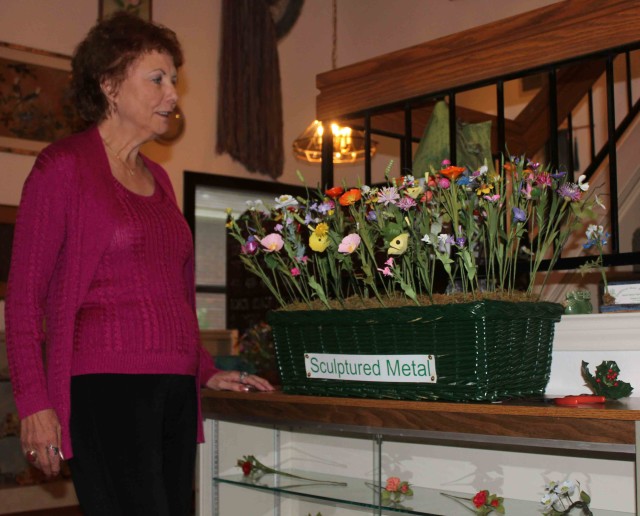Texas Nature Art Thrives Despite Cool Attitude of Galleries and Shows

Janice Clark’s Texas wildflowers, sculpted in aluminum, attract plenty of buyers despite dealers’ lack of interest in naturalistic art. Photo by Caroline Khoury.
By Caroline Khoury
For Reporting Texas
Janice Clark dissects wildflowers, studies their structure and then recreates them, in intricate detail, in aluminum. Her bouquets are exact copies of the flowers that inspire her.
“I wanted it to look like you went out into the garden or the field, picked them, brought them in and put them in the vase,” said Clark, who has been recreating nature in metal for more than 40 years. “I don’t paint the flowers anything but the color that they grow in.”
Clark, who lives in Garland, has shown her work at art fairs across the state, including the annual Artists and Artisans show at the Lady Bird Johnson Wildflower Center in Austin.
But times have been changing for Clark and other artists who celebrate Texas wildflowers and wildlife with realistic portrayals, and who depend on art shows to gain a following and sell their work. Increasingly, the expert juries that decide which artists can exhibit at the high-profile shows are not interested in realistic art, said several artists. Those shows, which award prizes for the best work, are important for building artists’ reputations and attracting new customers, including collectors.
“The traditional type of stuff like that you don’t see in art shows and in really high-powered competitions. So much of it is contemporary art now,” said Joseph Hammer, director of product marketing at the wildflower center.
People who attend the juried shows also tend to have less interest in naturalistic art, Hammer said.
According to Steve Kriechbaum, a goldsmith and previous juror with the Austin Fine Art Show, the phenomenon of realistic artist being rejected from art shows has been going on for years.
“[Realistic artwork] is just not offered as much because the powers in the art world are not selecting it. The current jury pool is coming from academia. They are making the decision for the buying public rather than letting the artwork stand on its own,” Kriechbaum said.
Dan Baker, artist and organizer of the annual Texas Masters of Fine Art and Craft show in Kerrville, said some judges aren’t knowledgeable about naturalistic art, which causes them to overlook details and craftsmanship.
Referring to Clark’s work, Baker said, “It would be impossible for her to get into a show these days that is not a specialized show. The judges deciding which artists can exhibit will see only a few pictures of her metal flowers, and won’t understand the work involved.”
Melanie Fain, a naturalist printmaker and watercolorist from Boerne who has participated in shows for more than 30 years, said her work was accepted at a show in Southlake that was heavy on contemporary art.
“The people who are doing representational art, or doing more non-contemporary, I think may be having a bit of a problem just because of who is judging the art and what [the jury] think is exciting or what they perceive is going to draw people in,” Fain said. She will exhibit at nature-art shows early next year in South Carolina and Oklahoma, as well as the Kerrville show in May, which includes contemporary as well as naturalistic arts and crafts.
Mary Lambeth of Midland, who has been painting wildflowers for more than 10 years, expressed frustration that naturalistic artwork was being rejected at certain shows, but said the appreciation of wildlife artwork will return.
“I think everything is kind of cyclical. I think it will come back eventually,” Lambeth said. “The contemporary stuff is, I guess, more popular now.”
Naturalistic artists have other channels for promoting their work, including the non-juried shows that are open to any artist willing to pay for a booth. Baker says there are hundreds of smaller, public art shows and festivals that are open to the public.
“We’ve had very successful artists who have shown at the wildflower center that are showing at public shows and festivals and things, not the fancy gallery, competition type things,” Hammer said. “They sell their art every weekend at the public shows.”
Kriechbaum said, “What’s important is that the buying public will still buy that [realistic] work. You just have to go to places that will show your work.”
Baker and Kriechbaum agree that printmaker Fain is a prime example of a realistic artist who is thriving because she knows which shows and outlets will accept her work. She sends work to be juried to a show called Western Visions in Jackson, Wyo., that partners with the National Museum of Wildlife Art.
Fain said she believes in the power of having a website and having a Facebook presence to promote your work.
Metal flower maker Clark does just as well selling her art through her mailing list.
Clark learned her craft in the 1970s at a class for military wives in Virginia, where her husband was studying at the Joint Forces Staff College in Norfolk. Over the years, making the flowers has become a passion and a business, and she has built up a big following, some of whom own every flower in her collection.
“I have a list of customers waiting for flowers,” said Clark, who creates one or two new Texas wildflowers to add to her collection every year. “I have customers who call to see which flowers they already have and which flowers are new to the collection so they can prepare for which ones to buy next.”
She says she enjoys the experience of shows and would rather speak to her customers than sell online. She’s already on the schedule for Kerrville and wildflower center shows next year.
“I like to actually talk and visit with people that are interested in the wildflowers. I don’t do this for the living,” Clark said. “I do it because I enjoy it and because people enjoy the flowers.”